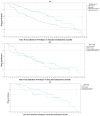Comparative Outcomes of Adalimumab and Infliximab Dose Escalation in Inflammatory Bowel Disease Patients Failing First-Line Biologic Treatment
- PMID: 40004757
- PMCID: PMC11857063
- DOI: 10.3390/jcm14041228
Comparative Outcomes of Adalimumab and Infliximab Dose Escalation in Inflammatory Bowel Disease Patients Failing First-Line Biologic Treatment
Abstract
Background/Objectives: Dose escalation has been commonly used to achieve and maintain response. We aimed to compare the outcomes of adalimumab or infliximab dose escalation in inflammatory bowel disease (IBD) patients. Methods: Treatment persistence (TP) and predictive factors for remission-free treatment discontinuation (r-fTD) were evaluated in patients treated with adalimumab or infliximab dose escalation between 2019 and 2024. Results: Dose escalation was identified in 142 patients treated with adalimumab (UC: 23.9%; CD: 76.1%) and in 126 patients treated with infliximab (UC: 23.8%; CD: 76.2%). The TP rate was significantly lower in the adalimumab group (35.2%) than the infliximab group (53.2%) (p = 0.003). The survival analysis showed that drug persistence was lower in the adalimumab group compared with the infliximab group (mean time: 74.3 vs. 99.5 months, p < 0.001). TP rates showed no significant differences between UC and CD for both adalimumab (mean time UC: 64.7 months vs. CD: 76.2 months, p = 0.403) and infliximab (mean time UC: 80.3 months and CD: 102.6 months, p = 0.151). The r-fTD rates were significantly higher in the adalimumab group (62.7%) than the infliximab group (39.7%) (p < 0.001). Primary lack of response and secondary loss of response (sLOR) rates were both higher in the adalimumab group (7.7% and 51.4%) than the infliximab group (1.6% and 28.6%). However, serious adverse events were lower in the adalimumab group (2.1%) than the infliximab group (7.9%) (p = 0.027). Conclusions: Infliximab dose escalation was more effective than adalimumab in both UC and CD patients. Regarding the side effect profile, adalimumab dose escalation was found to be safer compared with infliximab.
Keywords: Crohn’s disease; adalimumab; dose escalation; inflammatory bowel disease; infliximab; ulcerative colitis.
Conflict of interest statement
The authors declare that they have no conflicts of interest.
Figures

References
-
- Bernstein C.N., Eliakim A., Fedail S., Fried M., Gearry R., Goh K.-L., Hamid S., Khan A.G., Khalif I., Ng S.C., et al. World Gastroenterology Organisation Global Guidelines Inflammatory Bowel Disease: Update August 2015. J. Clin. Gastroenterol. 2016;50:803–818. doi: 10.1097/MCG.0000000000000660. - DOI - PubMed
-
- Kósa F., Kunovszki P., Borsi A., Iliás Á., Palatka K., Szamosi T., Vincze Á., Molnár T., Lakatos P.L. Anti-TNF Dose Escalation and Drug Sustainability in Crohn’s Disease: Data from the Nationwide Administrative Database in Hungary. Dig. liver Dis. Off. J. Ital. Soc. Gastroenterol. Ital. Assoc. Study Liver. 2020;52:274–280. doi: 10.1016/j.dld.2019.09.020. - DOI - PubMed
LinkOut - more resources
Full Text Sources

